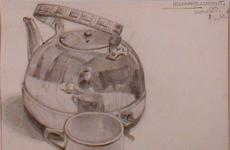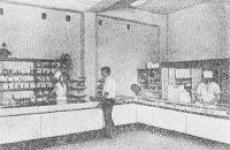Body receptors. Educational portal
Receptor (from the Latin word - receiving) in biology has two meanings. In the first value, the receptors are called sensitive nervous endings or specialized cells that perceive irritations from the outer or internal medium and transform them into the nervous excitation transmitted in the form of a stream of nerve pulses to the central nervous system organism.
The primary receptors are distinguished, which are simple nervous endings of centripetal process nerve cells - Neurons, and secondary receptors having specialized cells to perceive certain irritation. The primary receptors include, for example, the nerve endings in the skin, perceiving tactile and pain irritation, and the secondary - olfactory cells of the nasal cavity, columns and retinal wands that perceive light. Sticks are modified epithelial cells containing substances capable of disintegrating light. The resulting decomposition products cause changes in the activity of these cells, which are recorded and treated with retinal neurons. Depending on the degree of excitation of mobs and sticks of neurons, the flow of nerve pulses sent to the brain is reinforced or weakened. Other secondary receptors, perceive sound oscillations, pressure on the skin, body position in space are also working according to a similar principle.
Extractors (exteroceptors), perceive external irritation: temperature, touch, light, sounds, taste, smell, etc.; Intereceptors (inter -ceptor), registering the state of the internal environment of the body: chemical composition blood, its pressure on the walls of the vessel, work internal organs; Saproporeceptors (proprioceptors), perceive tendon tension, change the length of muscle fibers, a ligament. Receptors that perceive mechanical effects are called mechanoreceptors, chemical irritations - chemoreceptors, pressure - baroreceptors.
In the second value of this term, the receptors are called cell membranes sensitive to certain substances and transmitting information about such a signal into the cell. In fact, membrane receptors are special protein molecules capable of identifying molecules of certain compounds - proteins, peptides, low molecular weight hormones, growth factors and other substances. In most cases, the receptor connection with a signal molecule activates a special enzyme. Receptors are arranged so that the molecules or parts of these molecules are identifiable by them are capable of entering receptors as the key in locking well. In this case, the condition and activity of the cells change. For example, muscle fiber receptors providing cardiac automation are sensitive to hormones - adrenaline and acetylcholine. The first hormone enhances the activity of the heart, the second - it slows down.
Membrane receptors operate also in places of connecting two nerve cells - synapses. The nervous end of one cell highlights a special substance - the mediator (for example, acetylcholine). Receptors on the surface of another cell perceive this signal and excite the second cell.
Receptors are specific nerve formations that are the endings of sensitive (afferent) nerve fibers that can be excited under the action of an irritant. Receptors that perceive irritation from external environmentare called exceptoceptors; Perceiving irritation from the inner environment of the organism - inter -ceptor. A group of receptors located in skeletal muscles and tendons and signaling muscles are distinguished - proprioceptors.
Depending on the nature of the irritant, the receptors are divided into several groups.
1. Mechanoreceptors to which tactile receptors include; Baroreceptors located in the walls of blood vessels and react to changing blood pressure; Fournorecaptors reacting to air fluctuations created by sound irritant; The receptors of the parental apparatus that perceive changes in the position of the body in space.
2. Chemoreceptors reacting when exposed to any chemical substances. These include Omersicceptors and glukectorics, perceive, respectively, changes in the osmotic pressure and blood sugar levels; Taste and olfactory receptors that perceive the presence of chemicals in environment.
3. Thermoreceptors that perceive the change in temperature both inside the body and in the surrounding organism.
4. Photoreceptors located in the retina eye perceive light stimuli.
5. Pain receptors are highlighted in a special group. They can be excited by mechanical, chemical and temperature stimuli of such a force, in which their destructive effect on tissues or organs is possible.
Morphologically receptors can be in the form of simple free nervous endings or to have the shape of hairs, spirals, plates, washers, balls, colodes, sticks. The structure of the receptors is closely related to the specificity of adequate stimuli, to which the receptors have high absolute sensitivity. For the excitation of photoreceptors, only 5-10 luminous quanta is sufficient for excitation of olfactory receptors - one pieces molecule. With prolonged exposure of the stimulus, the receptors are adapting, which is manifested in reducing their sensitivity to an adequate stimulus. There are quickly adapting (tactile, baroreceptors) and slowly adaptable receptors (chemoreceptors, phonorecaptors). Vestibulotors and proproceptors, unlike them, do not adapt. In receptors, under the action of an external stimulus, the depolarization of its surface membrane occurs, which is indicated as a receptor or generator potential. Having achieved a critical value, it causes the discharge of afferent excitation pulses in the nervous fiber from the receptor. The information perceived by receptors from the inner and external environment of the body is transmitted by afferent nervous ways In the central nervous system, where it is analyzed (see analyzers).
5.1.1. Concept of receptors
In physiology, the term "receptor" is used in two values.
First, it is touch receptors -
specific cells configured to the perception of various irritants of the external and internal environment of the body and having a high sensitivity to an adequate stimulus. Sensory receptors (lat. Ge-Ceptum - Take) perceive irregular
residents of the outer and internal environment of the body by converting irritation energy into the receptor potential, which is converted to nerve impulses. To other - inadequate stimuli - they are small. Inadequate stimuli can excite receptors: for example, the mechanical pressure on the eye causes a feeling of light, but the energy of an inadequate stimulus should be in millions and billions of times more adequate. Sensory receptors are the first link in the reflex pathway and the peripheral part of a more complex structure - analyzers. A combination of receptors whose stimulation leads to a change in the activity of any nerve structures, is called a receptive field. Such a structure can be afferent fiber, afferent neuron, a nervous center (respectively, a receptive field of afferent fiber, neuron, reflex). The recipe field of the reflex is often referred to as the reflexogenic zone.
Secondly, it effective receptors (cytoreceptors), which are protein structures of cell membranes, as well as cytoplasm and kernels that can associate active chemical compounds (hormones, mediators, medicines, etc.) and run the cell responses to these compounds. Effective receptors have all the cells of the body, in the neurons there are especially many synaptic intercellular contacts on the membranes. This chapter discusses only sensory receptors that ensure the admission of information on the external and internal environment of the body into the central nervous system (CNS). Their activity is prerequisite To implement all the functions of the CNS.
5.1.2. Classification of receptors
The nervous system is characterized by a large variety of receptors, different types which are presented in Fig. 5.1.
A. The central place in the classification of receptors occupies their division depending on the type of perceived irritant. There are five such types of receptors.
1. Mechanoreceptors they are excited in mechanical deformation. They are located in the skin, vessels, internal organs, musculoskeletal, hearing and vestibular systems.
2. Chemoreceptors perceive chemical changes in external and internal
the environment of the body. These include flavoring and olfactory receptors, as well as receptors reacting to the change in blood composition, lymph, intercellular and cerebrospinal fluid (change of voltage O 2 and CO 2, osmolarity, pH, glucose levels and other substances). Such receptors are in the mucous membrane of the language and nose, carotid and aortic calves, the hypothalamus and the oblong brain.
3. Thermoreceptor - perceive temperature changes. They are divided into thermal and cold receptors and are in the skin, vessels, internal organs, hypothalamus, middle, oblong and spinal cord.
4. Photoreceptors in the retina, the eyes perceive light (electromagnetic) energy.
5. NOCITSITERS - their excitement is accompanied by painful sensations (pain receptors). The stimuli of these receptors are mechanical, thermal and chemical (histamine, bradykin, K +, N +, etc.) factors. Pain incentives are perceived by free nervous endings that are in the skin, muscles, internal organs, dentina, vessels.
B. from a psycho-physiological point of viewreceptors are subdivided in accordance with the senses and the resulting sensations for visual, hearing, taste, olfactory and tactile.
B. By location in the bodyreceptors are divided into extero and interoreceptors. Exterruseceptors include leather receptors, visible mucous membranes and sense organs: visual, hearing, taste, olfactory, tactile, skin pain and temperature. Internal organ receptors (visceororeceptors), vessels and CNS belong to interoreceptors. A variation of interior is the receptors of the musculoskeletal system (propororeceptors) and vestibular receptors. If the same type of receptors (for example, chemoreceptors to CO 2) are localized both in the CNS (oblongable brain) and in other places (vessels), then such receptors are subdivided into central and peripherals.
Depending on the degree of specificity of receptors,those. Their ability to respond to one or more types of irritants, allocate monomodal and polymodal receptors. In principle, each receptor can respond not only to adequate, but also on an inadequate stimulus, but
difficulty to them is different. Receptors whose sensitivity to adequate irritant is much superior to those inadequate called monomodal.Monomodality is especially characteristic of exterorceptors (visual, auditory, taste, etc.), but there are monomodal and interoreceptors, such as carotid sinus chemoreceptors. Polymodalreceptors are adapted to the perception of several adequate stimuli, such as mechanical and temperature or mechanical, chemical and pain. Polymodal receptors include, in particular, irritant lung receptors, perceive both mechanical (dust particles) and chemical (odorous substances) stimpers in the inhaled air. The difference in sensitivity to adequate and inadequate stimuli in the polymodal receptors is less pronounced than the monomodal.
D. on a structural and functional organizationdistinguish primary and secondary receptors. Primaryrepresent sensitive ending of dendrita afferent neuron. The neuron body is usually located in the spinal ganglia or in the ganglia of cranial nerves, in addition, for the autonomic nervous system - in the extra- and in-trargan ganglia. In the primary recipe
re irritant acts directly at the end of the sensory neuron (see Fig. 5.1). A characteristic feature of such a receptor is that the receptor potential generates the potential of action within the same cell - sensory neuron. Primary receptors are phylogenetically more ancient structures, they include olfactory, tactile, temperature, pain receptors, propriumoregtep-tori, internal organ receptors.
In secondary receptorsthere is a special cell that is synaptically associated with the end of the dendrite of the sensory neuron (see Fig. 5.1). This is a cell of the epithelial nature or neuroectodermal (for example, a photoreceptor) of origin. For secondary receptors, it is characteristic that the receptor potential and the action potential occur in different cells, while the receptor potential is formed in a specialized receptor cell, and the action potential is in the end of the sensory neuron. The secondary receptors include auditory, vestibular, taste receptors, retina photoreceptors.
E. in the speed of adaptationreceptors are divided into three groups: quickly adapting(phase), slow adaptable(tonic) and mixed(phase tonic), adaptive
at average speed. An example of rapidly adaptable receptors are vibration receptors (Pacini Taurus) and Touch (Maissener Taurus) of the skin. Slowly adaptable receptors include proproporeceptors, pulmonary stretching receptors, part of pain receptors. Retinal photoreceptors, skin thermistors are adapting at average speed.
5.1.3. Receptors like sensory converters
Despite the large variety of receptors, in each of them there are three main stages of irritation energy transformation into a nervous impulse.
1. Primary irritation energy transformation. Specific molecular mechanisms of this process are not sufficiently studied. At this stage, the selection of irritants occurs: perceiving the structure of the receptor interacts with that irritable to which they are evolutionary. For example, with simultaneous action on the body of light, sound waves, Phacho-substance molecules The receptors are excited only under the action of one of the listed stimuli - an adequate stimulus capable of causing conformational changes of perceive structures (activation of the receptor protein). At this stage, the signal is gained in many receptors, so the energy of the forming receptor potential may be repeatedly (for example, in a photoreceptor of 10 5 times) more threshold irritation energy. The possible mechanism of the receptor amplifier is a cascade of enzyme reactions in some receptors, similar to the action of the hormone through the second intermediaries. Multiple reinforced reactions of this cascade change the state of ion channels and ionic currents, which forms receptor potential.
2. Formation of receptor potential (RP). In the receptors (except for photoreceptors), the energy of the stimulus after its conversion and amplification leads to the opening of sodium channels and the appearance of ionic currents, among which the main role is played by the incoming sodium current. It leads to depolarization of the receptor membrane. It is believed that in the chemoreceptors, the discovery of channels is associated with a change in the form (conformation) of portable protein molecules, and in the mechanorecepto-rah - with a stretch of the membrane and the extension of the channels. In sodium photoreceptors
the current flows in the dark, and under the action of light, the sodium channels are closed, which reduces the incoming sodium current, so the receptor potential is submitted not depolarization, but hyperpolarization.
3. Transformation of the RP into the action potential. The receptor potential does not have in contrast to the potential of the action of regenerative depolarization and can be distributed only electrotonically into small (up to 3 mm) distances, since it decreases its amplitude (attenuation). In order for the information of the sensory stimuli to reach the central nervous system, the RP must be transformed into the action potential (PD). In primary and secondary receptors, this occurs in different ways.
In primary receptorsthe receptor zone is part of the afferent neuron - the end of his dendrite. The emerging RP, spreading electrotonic, causes depolarization in the neuron sites, in which the occurrence of PD is possible. In the world-linovy \u200b\u200bfibers, PD occurs in the nearest interceptions of Ranviers, in the non-relatives - the nearest sites that have sufficient concentration of potential-dependent sodium and potassium channels, and with short dendrites (for example, in olfactory cells) - in the axonny holly. If the membrane depolarization at the same time reaches the critical level (threshold potential), then the PD generation occurs (Fig. 5.2).
In secondary receptorsRP occurs in the epithelial receptor cell, synap-tically associated with the end of the dendrita of the afferent neuron (see Fig. 5.1). The receptor potential causes the mediator to be released into the SI-suppl. Under the influence of the mediator on a postsynaptic membrane arises generator potential(exciting postsynaptic potential), which ensures the occurrence of PD in the nervous fiber near the postsynaptic membrane. Receptor and generator potentials are local potentials.
Skin receptors are responsible for our ability to feel touched, warm, cold and pain. Receptors are modified nervous endings that can be both free non-specialized and encapsulated complex structures that are responsible for a certain type of sensitivity. Receptors perform a signal role, so they are necessary for a person for efficient and safe interaction with the external environment.
The main types of skin receptors and their functions
All types of receptors can be divided into three groups. The first group of receptors is responsible for tactile sensitivity. These include Taurus Paper, Maisner, Merkel and Ruffhini. The second group is
thermoreceptor: Krause flasks and free nervous endings. The group includes pain receptors.
The vibrations are more sensitive to the palms and fingers: due to the large number of packing receptors in these zones.
All types of receptors have different zones By width of sensitivity, depending on the function that they perform.
Skin receptors:
. Skin receptors responsible for tactile sensitivity;
. Skin receptors that react to temperature change;
. Nociceptors: Skin receptors responsible for pain sensitivity.

Skin receptors responsible for tactile sensitivity
There are several types of receptors responsible for tactile sensations:
. Pacinum Taurus is quickly adapting receptors that have wide recipe fields. These receptors are located in subcutaneous fat tissue and are responsible for coarse sensitivity;
. Maisner Taurus is located in the dermis and have narrow reception fields, which causes their perception of fine sensitivity;
. Merkel Taurus - slowly adapt and have narrow receptor fields, and therefore their main function is a sense of surface structure;
. Taulz ruffini respond to sensations permanent pressure and are located, mainly in the sole area.
Also separately release receptors located inside the hair follicle, which signal the deviation of the hair from its initial position.
Skin receptors that react to change temperature
According to some theories for heat perception and cold exist different types receptors. For the perception of cold respond to flasks Krause, and hot - free nervous endings. Other theories of thermoreceptia argue that it is free nervous endings that are intended for the perception of temperature. In this case, thermal irritations are analyzed by deep nerve fibers, and cold-surface. Among the temperature sensitivity receptors form a "mosaic" consisting of cold and thermal spots.
Nociceptors: Skin receptors responsible for pain sensitivity
On the this stage There is no final opinion regarding the presence or absence of pain receptors. Some theories are based on the fact that free nervous endings that are located in the skin are responsible for the perception of pain.
Long-term and strong pain irritation stimulates the emergence of the flow of arms impulses, in connection with which the adaptation to pain slows down.
Other theories deny the presence of separate nocceptors. It is assumed that tactile and temperature receptors have a certain threshold of irritation, with the exceedment of which pain occurs.
In the classification of receptors, the central place occupies their division depending on the species of perceived irritant.There are five types of such receptors. one. Mechanoreceptorsthey are excited during their mechanical deformation, located in the skin, vessels, internal organs, the musculoskeletal, hearing and vestibular systems. 2. Chemoreceptorsperceive chemical changes in the outer and interior environment of the body. These include taste and olfactory receptors, as well as receptors that respond to the change in blood composition, lymph, intercellular and cerebrospinal fluid. Such receptors are in the mucous membrane of the language and nose, carotid and aortic tales, hypothalamus and the oblong brain. 3. Thermoreceptorperceive temperature changes. They are divided into thermal and cold receptors and are in the skin, mucous membranes, vessels, internal organs, hypothalamus, average, oblong and spinal cord. four. Photoreceptorsin the retina, the eyes perceive light energy. five. Nociceceptors,the initiation of which is accompanied by painful sensations. Irriters of these receptors are mechanical, thermal and chemical factors. Pain incentives are perceived by free nervous endings that are in the skin, muscles, internal organs, dentina, vessels. From a psycho-physiological point of view, the receptors are divided according to the senses and the resulting sensations on summary, auditory, taste, olfactory and tactile.
By location in the body, the receptors are divided into extero and interoreceptors. TO exterorceceptorsrecipes of leather, visible mucous membranes and sense organs: visual, hearing, taste, olfactory, tactile, pain and temperature. TO in-terrorispplatorspresent receptors internal organs, vessels and CNS. A variation of interior is the receptors of the musculoskeletal system (propororeceptors) and vestibular receptors. If the same type of receptor is localized both in the central nervous system (in the oblong brain) and in other places (vessels), then such receptors are divided into centraland peripheral.In the speed of adaptation, the receptors are divided into three groups: quickly adapting(phase), slow adaptable(tonic) and mixed(Phaznotonic), adapting at average speed. An example of quickly adaptable receptors are vibration receptors (Pachini Taurus) and Touch (Mason Taurus) to the skin. Slowly adaptable receptors include proproporeceptors, pulmonary stretching receptors, pain receptors. Retinal photoreceptors, skin thermistors are adapting at average speed. According to a structural and functional organization, primary and secondary receptors are distinguished. Primary receptorsrepresent sensitive ending of dendrita afferent neuron. The body of the neuron is located in the spinal brain ganglia or in the ganglia of the cranial nerves. In the primary receptor, the stimulus acts directly at the end of the sensory neuron. Primary receptors are phylogenetically more ancient structures, these include olfactory, tactile, temperature, pain receptors and proprigatorioreceptors. In secondary receptorsthere is a special cell that is synaptically associated with the end of the dendrite of the sensory neuron. This is a cell, for example, a photoreceptor, epithelial nature or neuroectodermal origin. This classification makes it possible to understand how the excitation of receptors arises. The receptor is a complex formation consisting of terminals (nerve endings) of dendrites of sensitive neurons, the glill, specialized formations of the intercellular substance and specialized cells of other tissues, which in the complex ensure the effect of the influence of factors of the outer or internal environment (stimulus) into the nervous impulse. Man receptors. Skin receptors. Pain receptors. Taurus pacying - Capsulated pressure receptors in a rounded multi-layer capsule. Located in subcutaneous fatty tissue. They are quicklyading (react only at the time of starting exposure), that is, the pressure is registered. Possess large recipe fields, that is, they represent a rough sensitivity. Mason Taurus - Pressure receptors located in the dermis. They are a layered structure with a nervous end passing between layers. Are fast-adapting. Possess small receptive fields, that is, they represent a thin sensitivity. Merkel Taurus - non-vaculated pressure receptors. They are slow-adaptable (react throughout the duration of exposure), that is, the pressure duration is recorded. Possess small receptive fields. Hair bulbs - react to the deviation of the hair. End of Ruffini - stretch receptors. They are slow-adaptable, possess large receptive fields. Blaze Krause - receptor reacting to cold. Muscle receptors and tendons
Muscular spindle - muscle stretch receptors, there are two types: with a nuclear bag, with a nuclear chain. Golgi tendon organ - muscle contraction receptors. When cutting the muscles, the tendon stretches and its fibers pinch the receptor ending, activating it. Configuration receptors are mainly free nervous endings, a smaller group - encapsulated. Type 1 is similar to the endings of the ruffini, type 2 - Pachchini Tales. Receptors retina eye. The retina contains sticks (sticks) and columine (columbles) photosensitive cells that contain photosensitive pigments. Wands are sensitive to very weak light, these are long and thin cells oriented along the axis of light passage. All wands contain the same photosensitive pigment. The columns require much more bright lighting, these are short cone-shaped cells, a man of columns are divided into three types, each of which contains its photosensitive pigment - this is the basis of color vision. Under the influence of light in the receptors, a fading occurs - the visual pigment molecule absorbs the photon and turns into another compound, worse absorbing light of the waves (this wavelength). Almost all animals (from insects to man) this pigment consists of a protein to which a small molecule is attached close to Vitamin A.
15. Transformation of the energy of the irritant in the receptors. Receptor and generator potentials. Weber-Ferehner law. Absolute and differential sensitivity thresholds.
Stages of converting the energy of an external stimulus into the energy of nerve impulses. The action of the stimulus. The outer stimulus interacts with the specific membrane structures of the endings of a sensitive neuron (in the primary receptor) or a recitener cell (in the secondary receptor), which leads to a change in the ion permeability of the membrane. Generation of receptor potential. As a result of changing the ion permeability, a change in the membrane potential (depolarization or hyperpolarization) of a sensitive neuron (in the primary receptor) or a recipe cell (in the secondary receptor) is occurring. The change in the membrane potential, which occurs as a result of the action of the stimulus, is called receptor potential (RP). Distribution of receptor potential. In the primary receptor, the RP applies electrotonyically and reaches the nearest interception of Ranvier. In the secondary receptor, the RP is electrotonyically propagated by the recipe cell membrane and reaches the presynaptic membrane, where the mediator is distinguished. As a result of the triggering of synapse (between the recipe cell and sensitive neuron), depolarization of the postsynaptic membrane of sensitive neuron (VSPS) occurs. The formed VSP extends electrotonically by dendrituit of a sensitive neuron and reaches the nearest interception of Ranvier. In the area of \u200b\u200binterception, Ranvier RP (in the primary receptor) or VSPP (in the secondary receptor) is converted into a series of PD (nerve pulses). Formed nerve impulses are carried out on axon (central process) of sensitive neuron in the central nervous system. Since RP generates the formation of a series of PD, it is often called generator potential. The patterns of transformation of the energy of an external stimulus into a series of nerve impulses: the higher the power of the current stimulus, the greater the amplitude of the RP; The more the amplitude of the RP, the greater the frequency of the nerve impulses. Receptor and generator potentials are particular cases of electrical potentials. When a receptor (sensory) cell, for example, a mecho-sensitive wicked or flavored, is exposed to an appropriate incentive, a more or less complex set of events leading to changes in the electrical polarity of the area of \u200b\u200btheir membrane is implemented. This phenomenon is called receptor potential. In most cases, receptor potentials are depolarization, in others, however, in particular in chopsticks and mobcles, it is hyperpolarization. One way or another, the result is the same - there are currents between the subjected to the membrane exposed and other sections of the receptor cell membrane. In general, changes in electrical polarity (increasing it or reduction) affects the selection of the mediator to the subject-to-touch neuron. Not all sensory systems developed specialized sensory cells. Obony and some mechanoreceptive systems are built on neurosensory cells. In such cases, the detection functions of the corresponding factors of the external environment and the transmission of information in the brain are combined in one cell. Electrophysiological phenomena at the same time are similar to just described. When the sensitive ending of the neurosensory cell is exposed to an incentive, a number of biochemical processes lead to a change in electric potential (in the case of neurosensory cells, it is always depolarization). The mechanism of local currents is such that depolarization extends to the area of \u200b\u200bthe membrane, which is replete with potential-dependent Na + -Kanals. If depolarization is sufficiently large, Na +-channels open, with the result that the action potential is generated, which is transmitted without a decrement to the central nervous system. Since the initial depolarization occurs not in a special receptor cell, it is often referred to as the generator potential. Many, however, both options are called receptor potentials. The amplitude of generator and receptor potentials depends on the magnitude of the incentive - there is almost direct proportional dependence between the potential and intensity of the incentive. Due to the fact that local currents should be quite significant in magnitude to run the mediator selection or activate at least part of the population of the potential-dependent Na +-channels to the threshold level, the launch of the action potential in the sensory nerve is observed only when the receptor or generator potential reaches defined amplitude. In other words, the potential of action is not generated until the stimulus reaches a critical value. Weber's law - ferechner - empirical psychophysiological law, which consists in the fact that the intensity of the sensation is proportional to the logarithm of the intensity of the intensity.






